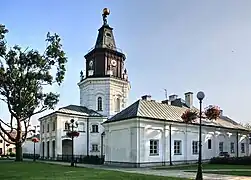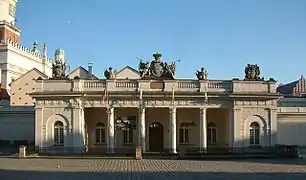



Neoclassical architecture in Poland was centered on Warsaw under the reign of Stanisław August Poniatowski, while the modern concept of a single capital city was to some extent inapplicable in the decentralized Polish–Lithuanian Commonwealth.[1][2][3] Classicism came to Poland in the 18th century as the result of French infiltrations into the Polish millieu.[4] The best-known architects and artists who worked in Poland were Dominik Merlini, Jan Chrystian Kamsetzer, Szymon Bogumił Zug, Stanisław Zawadzki, Efraim Szreger, Antonio Corazzi, Jakub Kubicki, Hilary Szpilowski, Christian Piotr Aigner, Wawrzyniec Gucewicz, Bonifacy Witkowski and Danish Bertel Thorvaldsen.[5]
The first stage, called the Stanislavian style, followed by an almost complete inhibition and a period known as the Congress Kingdom classicism.[6] The palladian patterns were independently interpreted by Szymon Bogumił Zug, who followed an influence of radical French classicism.[7] A palladian by influence was also Piotr Aigner - author of the facade of St. Anne's Church in Warsaw (1786-1788) and St. Alexander Church (1818-1826).[7] Palladian ideas were implemented in a popular type of a palace with a pillared portico.[7]
The most famous buildings of the Stanislavian period include the Royal Castle in Warsaw, rebuilt by Dominik Merlini and Jan Christian Kamsetzer, Palace on the Water, Królikarnia and the palace in Jabłonna. Kamsetzer erected the Amphitheatre in the Royal Baths Park and the Warsaw palaces of the Raczyńskis and Tyszkiewiczs as well as the palace in Iskierniki. Among the most notable works by Szymon Bogumił Zug is a palace in Natolin and Holy Trinity Church and gardens: Solec, Powązki, Mokotów and Arcadia near Nieborów.
From the period of the Congress Kingdom are Koniecpolski Palace and the St. Alexander's Church in Warsaw, the Temple of the Sibyl in Puławy, rebuilding the Łańcut Castle. The leading figure in the Congress Kingdom was Antoni Corrazzi.[7] Corazzi has created a complex of Bank Square in Warsaw, the edifices of the Treasury, Revenue and the Commission of Government, the building of the Staszic Palace, Mostowski Palace and designed the Grand Theatre. Belvedere and Pawłowice were created by Jakub Kubicki, while Lubostroń and Dobrzyca by Stanisław Zawadzki. The notable town halls in Łowicz, Płock, Błonie, Konin and Aleksandrów Łódzki are dating back the first half of the nineteenth century.
Stanislavian classicism gallery
- Palaces
 Łazienki Palace in Warsaw, 1764-1795
Łazienki Palace in Warsaw, 1764-1795 Marynka Palace in Puławy, 1790-1794
Marynka Palace in Puławy, 1790-1794 Królikarnia Palace in Warsaw, 1782-1786
Królikarnia Palace in Warsaw, 1782-1786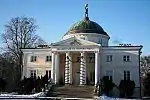 Skórzewski Palace in Lubostroń, 1795-1800
Skórzewski Palace in Lubostroń, 1795-1800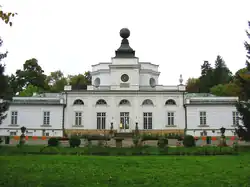 Poniatowski Palace in Jabłonna, 1775-1779
Poniatowski Palace in Jabłonna, 1775-1779 Lubomirski Palace in Niezdów, 1776-1804
Lubomirski Palace in Niezdów, 1776-1804 Potocki Palace in Natolin, 1780-1782
Potocki Palace in Natolin, 1780-1782.jpg.webp) Gorzeński Palace in Dobrzyca, 1795-1799
Gorzeński Palace in Dobrzyca, 1795-1799
- Churches
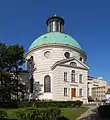 Holy Trinity Church in Warsaw, 1777-1782
Holy Trinity Church in Warsaw, 1777-1782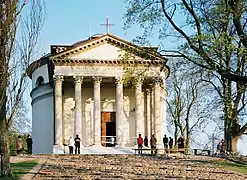 Church of the Assumption of Mary in Puławy, 1801-1803
Church of the Assumption of Mary in Puławy, 1801-1803
- Park structures
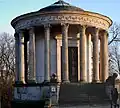 Sybil Temple in Puławy, 1798-1801
Sybil Temple in Puławy, 1798-1801 The Aqueduct in Arkadia (Nieborów), 1784
The Aqueduct in Arkadia (Nieborów), 1784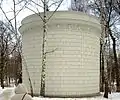 Water Tower in the Royal Baths (Warsaw), 1777–1778
Water Tower in the Royal Baths (Warsaw), 1777–1778 Panteon in Dobrzyca, before 1806
Panteon in Dobrzyca, before 1806
Congress Kingdom classicism gallery
- Palaces
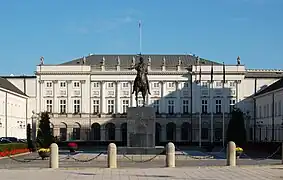 Presidential Palace in Warsaw, 1818
Presidential Palace in Warsaw, 1818 Staszic Palace in Warsaw, 1820-1823
Staszic Palace in Warsaw, 1820-1823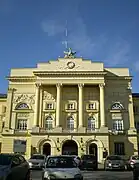 Mostowski Palace in Warsaw, 1823-1824
Mostowski Palace in Warsaw, 1823-1824 Czartoryski Palace in Puławy, 1840-1843
Czartoryski Palace in Puławy, 1840-1843
- Public edifices
 Great Theatre in Warsaw, 1825-1833
Great Theatre in Warsaw, 1825-1833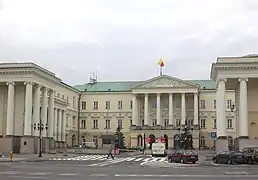 Commission Palace in Warsaw, 1823-1825
Commission Palace in Warsaw, 1823-1825 Ministry of Treasury in Warsaw, 1825-1828
Ministry of Treasury in Warsaw, 1825-1828 Polish Bank in Warsaw, 1825-1828
Polish Bank in Warsaw, 1825-1828 Town hall in Łowicz, 1825-1828
Town hall in Łowicz, 1825-1828 Town hall in Płock, 1816-1827
Town hall in Płock, 1816-1827 New town hall in Lublin, 1827-1828
New town hall in Lublin, 1827-1828 City hall in Łódź, 1826-1827
City hall in Łódź, 1826-1827
- Churches
 St. Alexander's Church in Warsaw, 1818-1825
St. Alexander's Church in Warsaw, 1818-1825 St. Alexander's Church in Suwałki, 1820-1829
St. Alexander's Church in Suwałki, 1820-1829 St. John the Baptist's Church in Brzostków, 1839-1840
St. John the Baptist's Church in Brzostków, 1839-1840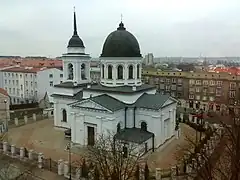 St. Nicholas Orthodox Cathedral in Białystok, 1843-1846
St. Nicholas Orthodox Cathedral in Białystok, 1843-1846
- Monuments and park structures
 Józef Poniatowski Monument in Warsaw, 1826-1827
Józef Poniatowski Monument in Warsaw, 1826-1827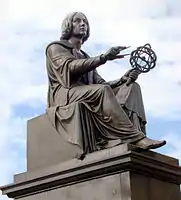 Nicolaus Copernicus Monument in Warsaw, 1828-1830
Nicolaus Copernicus Monument in Warsaw, 1828-1830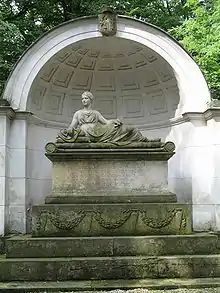 Sarcophagus of Natalia Sanguszkowa in Natolin, 1830
Sarcophagus of Natalia Sanguszkowa in Natolin, 1830 Sybil Temple in the Saxon Garden (Warsaw), 1852-1854
Sybil Temple in the Saxon Garden (Warsaw), 1852-1854
References
- ↑ The above mentioned buildings cannot in any way be compared with what was built in Warsaw at that time, because Warsaw become the real artistic capital of Poland. Much of the artistic work done in Warsaw was thanks to the sponsorship of Stanislaus Augustus. The creative artists gathered there and the most outstanding architects of the classicist period were very active. At that time, Kraków become artistically provincial. Michał Rożek, Doris Ronowicz (1988). Cracow: a treasury of Polish culture and art. Interpress Publishers. p. 74. ISBN 83-223-2245-3.
- ↑ John Stanley (March–June 2004). "Literary Activities and Attitudes in the Stanislavian Age in Poland (1764–1795): A Social System?". findarticles.com. Archived from the original on 2011-05-14. Retrieved 2009-04-23.
- ↑ Francis W. Carter (1994). Trade and urban development in Poland: an economic geography of Cracow, from its origins to 1795 – Volume 20 of Cambridge studies in historical geography. Cambridge University Press. pp. 186, 187. ISBN 978-0-521-41239-1.
- ↑ Marek Kwiatkowski (1983). Stanisław August, król-architekt (Stanislaus Augustus, the king-architect). Zakład Narodowy im. Ossolińskich. p. 274. ISBN 83-04-00850-5.
- ↑ Jon Stewart, Jon Bartley Stewart (2003). Kierkegaard and his contemporaries: the culture of golden age Denmark. Walter de Gruyter. p. 394. ISBN 3-11-017762-5.
- ↑ Manfred Kridl (1967). A survey of Polish literature and culture. Columbia University Press. pp. 192, 343.
- 1 2 3 4 Wojciech Słowakiewicz (2000). Wielka encyklopedia polski (in Polish). Fogra.
External links
 Media related to Neoclassical architecture in Poland at Wikimedia Commons
Media related to Neoclassical architecture in Poland at Wikimedia Commons


